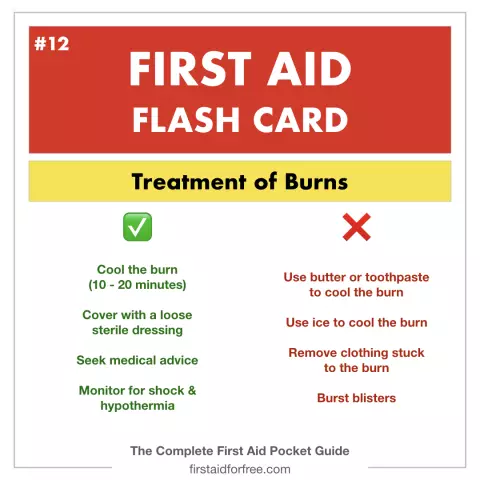- Author Rachel Wainwright [email protected].
- Public 2023-12-15 07:39.
- Last modified 2025-11-02 20:14.
First aid for a hogweed burn
Hogweed is a perennial plant that grows in Altai, Udmurtia, the Caucasus, the Urals, Siberia and central Russia. Its ribbed, hollow stem can reach a height of 150 cm. Outside, it is covered with fine hairs, and branches are located in the upper part of the stem. The leaves of the plant are very large. The root system is well developed. The hogweed blooms in June-July. Small white flowers are collected in a large umbrella, they have a pronounced spicy aroma. The plant bears fruit in August.

Source: depositphotos.com
There are about 50 species of hogweed. Some of them are used in traditional medicine, and some are poisonous, contact with them under certain conditions can lead to burns.
How does a hogweed burn?
The hogweed juice contains bergapten furocoumarin. This substance increases the susceptibility of human skin to ultraviolet radiation, that is, hogweed has phototoxic properties.
At the same time, the hogweed juice does not have an obvious irritating effect on the skin; directly upon contact with the plant, a person does not experience any discomfort. But if the skin is exposed to sunlight within 48 hours after contact, it will lead to severe burns. The severity of the burn will be the more, the more hogweed juice gets on the skin.
The phototoxic property is most pronounced in the hogweed during the flowering period. And, naturally, the likelihood of burns increases dramatically on clear and sunny days.
Children often get burns from hogweed in the area of the lips. This is due to the fact that children make spitting tubes or whistles from the hollow stems of a poisonous plant.
Allergy to cow parsnip is no less common. Essential oils act as an allergen, which determine the spicy pronounced aroma of the flower.
Burn symptoms
Symptoms of a hogweed burn can appear after quite a long time, sometimes several hours from the moment the plant sap contacts the skin. After the sun's rays hit the affected area of the skin, it begins to itch and redden. A little later, burn blisters form on it.
With numerous and severe burns, the victims' body temperature rises, headache and muscle pain occur, complaints of severe weakness, lack of appetite appear.
After the blisters open, erosion forms in their place, and then a long-term non-healing ulcer. Over time, it epithelizes, but dark spots remain on the skin, which persist for several years.
Inhalation of the essential oils secreted by hogweed is also fraught with danger. If you are near its thickets for a long time, then severe dizziness occurs, and a deep fainting may occur.
First aid for a hogweed burn
If there was a contact of the skin with a cow parsnip, to prevent a burn, you must:
- Blot the plant sap on the skin with any piece of cloth that has good absorbent properties. At the same time, try not to smear the juice on the surface of the skin.
- Protect the affected skin from exposure to sunlight by using long sleeves or a bandage.
All other activities should be carried out only indoors. The skin is washed with a soap and soda solution, and then wiped with a napkin, abundantly moistened with ethyl alcohol or vodka. The alcohol dissolves the furocoumarin bergapten, making it much easier to remove.
After cleaning the skin from the plant toxin, a preparation for burns is applied to it, for example, fir or sea buckthorn oil, Panthenol spray, Rescuer balm.
The affected area should be protected from sunlight or fluorescent lamps for two days, always kept covered with a bandage or clothing. After 48 hours, the bergapten furocoumarin that had been absorbed is destroyed, and the skin restores its resistance to ultraviolet radiation.
For 5 days, the victims need to take an antihistamine (Zodak, Fenkarol, Tavegil, Suprastin).
In case of a skin burn caused by contact with cow parsnip, in no case should you:
- disrupt the integrity of the blisters, as this can lead to the addition of a secondary infection and significantly lengthen the recovery time;
- lubricate the affected area of skin with vegetable juice, milk, fat or urine, as this increases the risk of wound infection;
- applying soil to the blisters can lead to tetanus infection.
When is medical attention required?
Usually, victims of contact with cow parsnip consult a doctor only in case of deep or large skin burns.
Treatment of deep or extensive skin lesions is carried out according to the general rules for the treatment of burn lesions. With the addition of infectious and inflammatory complications, antibacterial agents are indicated. If the victim complains of severe pain in the burned surface, he is prescribed non-steroidal anti-inflammatory drugs (Ketanal, Ibuprofen, Nimesil).
Possible consequences
After a burn caused by cow parsnip, dark spots remain on the skin for a long time, which can cause psychological discomfort, especially if they are located on open areas of the body.

Source: depositphotos.com
Burns by hogweed, occupying a large area, are very dangerous, since they can lead to the development of burn disease, accompanied by severe hypovolemia and exotoxic shock. If the area of the burn exceeds 80% of the skin surface, it can be fatal.
Prevention
Prevention of burns caused by hogweed juice is simple: direct contact with the poisonous plant must be avoided. However, it can be problematic to follow this advice in everyday life. The hogweed, possessing a strong and well-developed root system, grows rapidly. It is easy to miss it in the grass, since initial contact with it does not cause any unpleasant sensations.
To reduce the risk of a hogweed burn, you need to:
- show the children the hogweed and explain how dangerous it is to be near him, and even more so to touch him;
- when weeding a plot, protect hands with household gloves and use garden tools;
- it is advisable to carry out work on weeding the site in cloudy weather;
- after completing work on the site, change clothes and wash them, take a shower;
- when going to nature, put on clothes made of dense fabric that cover your arms and legs;
- clear your summer cottage or garden of cow parsnip before it begins to bloom.

Elena Minkina Doctor anesthesiologist-resuscitator About the author
Education: graduated from the Tashkent State Medical Institute, specializing in general medicine in 1991. Repeatedly passed refresher courses.
Work experience: anesthesiologist-resuscitator of the city maternity complex, resuscitator of the hemodialysis department.
Found a mistake in the text? Select it and press Ctrl + Enter.






